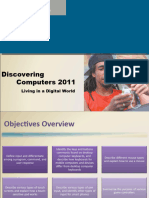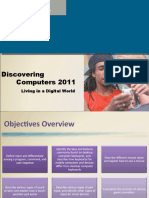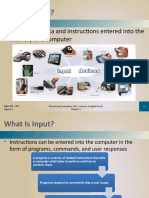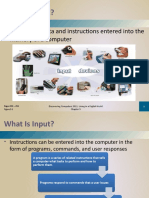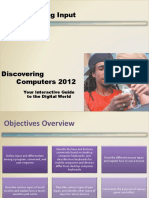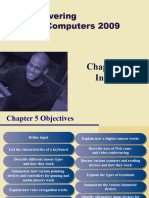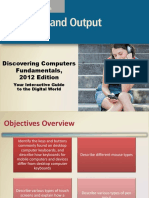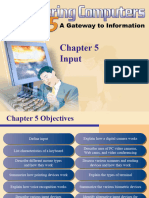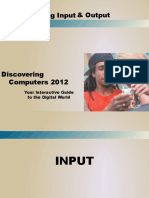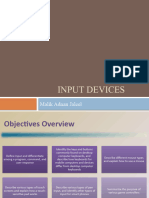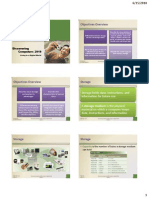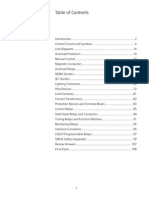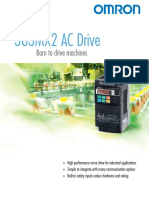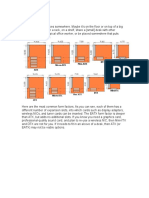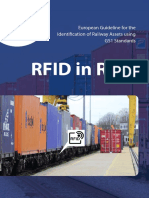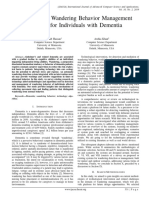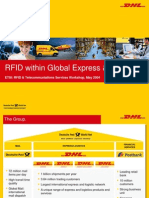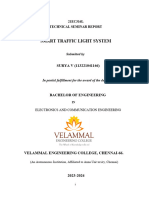8/17/2010
Objectives Overview
Discovering
Computers 2010
Define input and differentiate
among a program, command, and
user response
Identify the keys and buttons
commonly found on desktop
computer keyboards, and
describe how keyboards for
mobile computers and devices
differ from desktop computer
keyboards
Describe different mouse types
and explain how to use a mouse
Describe various types of touch
screens and explain how a touchsensitive pad works
Describe various types of pen
input, and identify other types of
input for smart phones
Summarize the purpose of various
game controllers
Living in a Digital World
See Page 257
for Detailed Objectives
Objectives Overview
What Is Input?
Explain how resolution
affects the quality of a
picture captured on a
digital camera
Describe the uses of
voice recognition,
Web cams, and video
conferencing
Discuss how various
scanners and reading
devices work
Summarize the various
biometric devices
Discuss how POS
terminals, automated
teller machines, and
DVD kiosks work
Identify alternative
input devices for
physically challenged
users
See Page 257
for Detailed Objectives
Discovering Computers 2010: Living in a Digital World
Chapter 5
Discovering Computers 2010: Living in a Digital World
Chapter 5
What Is Input?
Input is any data and instructions entered into the
memory of a computer
Pages 258 259
Figure 5-1
Discovering Computers 2010: Living in a Digital World
Chapter 5
What Are Input Devices
Instructions can be entered into the computer in the
form of programs, commands, and user responses
An input device
is any hardware
component that
allows users to
enter data and
instructions into
a computer
A program is a series of related
instructions that tells a computer what
tasks to perform and how to perform
them
Programs respond to commands that a
user issues
A user response is an instruction a user
issues by replying to a question
displayed by a program
Pages 258 - 259
Discovering Computers 2010: Living in a Digital World
Chapter 5
Page 260
Discovering Computers 2010: Living in a Digital World
Chapter 5
�8/17/2010
The Keyboard
The Keyboard
A keyboard is an input device that contains keys
users press to enter data and instructions into a
computer
Most desktop computer keyboards have
Page 560
Figure 5-2
Discovering Computers 2010: Living in a Digital World
Chapter 5
The Keyboard
Discovering Computers 2010: Living in a Digital World
Chapter 5
The Keyboard
The insertion point, also known as the cursor, is a
symbol on the screen that indicates where the
next character you type will appear
Page 261
Figure 5-3
Pages 260 - 261
Discovering Computers 2010: Living in a Digital World
Chapter 5
Wired
Keyboards
Page 262
Wireless
Keyboards
USB port
Bluetooth
Keyboard
port
IrDA
Discovering Computers 2010: Living in a Digital World
Chapter 5
The Keyboard
The Keyboard
An ergonomic keyboard has a design that reduces
the chance of wrist and hand injuries
Ergonomics incorporates comfort, efficiency, and
safety into the design of the workplace
Keyboards on mobile devices typically are smaller
and/or have fewer keys
Some phones have predictive text input, which
saves time when entering text using the phones
keypad
10
Click to view Web Link,
click Chapter 5, Click Web
Link from left navigation,
then click Ergonomics
below Chapter 5
Page 262
Figure 5-4
Discovering Computers 2010: Living in a Digital World
Chapter 5
11
Pages 262 263
Figure 5-5
Discovering Computers 2010: Living in a Digital World
Chapter 5
12
�8/17/2010
Pointing Devices
Mouse
A mouse is a pointing device that fits under the
palm of your hand comfortably
Most widely used pointing device on desktop
computers
A mouse can be wired or wireless
Page 263
Discovering Computers 2010: Living in a Digital World
Chapter 5
13
Mouse
Pages 263 264
Figures 5-6 and 5-7
Discovering Computers 2010: Living in a Digital World
Chapter 5
14
Other Pointing Devices
Right-click
Double-click
Triple-click
Drag
Right-drag
Rotate
wheel
Free-spin
wheel
Press wheel
Tilt wheel
Press thumb
button
Page 264
Figure 5-8
Discovering Computers 2010: Living in a Digital World
Chapter 5
15
Touch Screens and Touch-Sensitive Pads
A trackball is a
stationary
pointing
device with a
ball on its top
or side
Pages 265 266
Figures 5-9 5-11
A touchpad is
a small, flat,
rectangular
pointing
device that is
sensitive to
pressure and
motion
Pointing Stick
Click
Touchpad
Point
Trackball
Mouse operations
A pointing
stick is a
pressuresensitive
pointing
device shaped
like a pencil
eraser that is
positioned
between keys
on a keyboard
Discovering Computers 2010: Living in a Digital World
Chapter 5
16
Touch Screens and Touch-Sensitive Pads
A touch screen is a touch-sensitive display device
Microsoft Surface
Touch-sensitive pads
Click to view Web Link,
click Chapter 5, Click Web
Link from left navigation,
then click Multi-Touch Screens
below Chapter 5
Page 266
Figures 5-12 5-13
Discovering Computers 2010: Living in a Digital World
Chapter 5
17
Page 267
Figures 5-14 5-15
Discovering Computers 2010: Living in a Digital World
Chapter 5
18
�8/17/2010
Pen Input
Other Input for Smart Phones
With pen input, you touch a stylus or digital pen on a flat
surface to write, draw, or make selections
Click to view Web Link,
click Chapter 5, Click Web
Link from left navigation,
then click Signature Capture
Pads below Chapter 5
Page 268
Figure 5-16
Discovering Computers 2010: Living in a Digital World
Chapter 5
19
Game Controllers
Page 269
Figures 5-17 5-18
Discovering Computers 2010: Living in a Digital World
Chapter 5
20
Game Controllers
Video games and computer games use a game controller
as the input device that directs movements and actions
of on-screen objects
Gamepads
Click to view Web Link,
click Chapter 5, Click Web
Link from left navigation,
then click Wii Remote
below Chapter 5
Page 270
Joysticks and
Wheels
Dance pads
Light guns
Motionsensing
controllers
Discovering Computers 2010: Living in a Digital World
Chapter 5
21
Digital Cameras
Page 270
Figure 5-19
Discovering Computers 2010: Living in a Digital World
Chapter 5
22
Digital Cameras
A digital camera is a mobile device that allows
users to take pictures and store them digitally
Studio cameras
Field cameras
Point-and-shoot camera
Page 272
Discovering Computers 2010: Living in a Digital World
Chapter 5
23
Page 272
Figure 5-20
Discovering Computers 2010: Living in a Digital World
Chapter 5
24
�8/17/2010
Digital Cameras
Voice Input
Two factors affect the quality of digital camera photos:
Resolution
Number of bits
stored in each
pixel
Page 273
Voice input is the
process of entering
input by speaking into a
microphone
Voice recognition is the
computers capability of
distinguishing spoken
words
Resolution is the number of horizontal
and vertical pictures in a display device
A pixel is the smallest element in an
electronic display
Each pixel consists of one or more bits of
data
The more bits used to represent a pixel,
the more colors and shades of gray that
can be represented
Discovering Computers 2010: Living in a Digital World
Chapter 5
25
Page 274
Figure 5-22
Discovering Computers 2010: Living in a Digital World
Chapter 5
26
Voice Input
Voice Input
Audio input is the process of entering any sound
into the computer
Music production software allows users to record,
compose, mix, and edit music and sounds
Speech
Music
Sound Effects
Page 274
Discovering Computers 2010: Living in a Digital World
Chapter 5
27
Video Input
Page 274
Figure 5-23
Discovering Computers 2010: Living in a Digital World
Chapter 5
28
Discovering Computers 2010: Living in a Digital World
Chapter 5
30
Video Input
Video input is the process of capturing full-motion images and
storing them on a computers storage medium
Record video on a digital video (DV) camera or use a
video capture card to convert analog signals to digital
Connect the camera to a port on the system unit
Transfer video and images
Page 275
Discovering Computers 2010: Living in a Digital World
Chapter 5
29
Page 275
Figure 5-24
�8/17/2010
Video: Video Editing on Your Computer
Video Input
A Web cam is a type of digital video camera that
enables a user to:
Capture video and
still images
Click to view Web Link,
click Chapter 5, Click Web
Link from left navigation,
then click Web Cams
below Chapter 5
CLICK TO START
Discovering Computers 2010: Living in a Digital World
Chapter 5
31
Video Input
Pages 275 - 276
Send e-mail
messages with
video attachments
Broadcast live
images over the
Internet
Add live images to
instant messages
Make video
telephone calls
Discovering Computers 2010: Living in a Digital World
Chapter 5
32
Scanners and Reading Devices
A video conference is a meeting between two or
more geographically separated people
Flatbed
Pen or Handheld
Sheet-fed
Drum
Pages 276 277
Figures 5-25 5-26
Discovering Computers 2010: Living in a Digital World
Chapter 5
33
Scanners and Reading Devices
Page 277
Figure 5-27
Discovering Computers 2010: Living in a Digital World
Chapter 5
34
Scanners and Reading Devices
Optical character recognition (OCR) involves reading
characters from ordinary documents
A turnaround document is a document you return to the
company that creates and sends it
Page 278
Figure 5-28
Discovering Computers 2010: Living in a Digital World
Chapter 5
35
Page 279
Figures 5-29 5-30
Discovering Computers 2010: Living in a Digital World
Chapter 5
36
�8/17/2010
Scanners and Reading Devices
Scanners and Reading Devices
Optical mark
recognition (OMR)
reads hand-drawn
marks such as small
circles or rectangles
An OMR device scans
the documents and
matches the patterns of
light
A bar code reader, also
called a bar code
scanner uses laser
beams to read bar
codes
Click to view Web Link,
click Chapter 5, Click Web
Link from left navigation,
then click Bar Code Readers
below Chapter 5
Page 279
Figure 5-31
Discovering Computers 2010: Living in a Digital World
Chapter 5
37
Page 280
Figure 5-32
Discovering Computers 2010: Living in a Digital World
Chapter 5
Scanners and Reading Devices
Scanners and Reading Devices
RFID (radio frequency identification) uses radio signals to
communicate with a tag placed in or attached to an object
An RFID reader reads information on the tag via radio waves
RFID can track:
Magnetic stripe card readers read the magnetic
stripe on the back of cards such as:
Inventory
Location of
soldiers
Employee
wardrobes
38
Credit cards
Entertainment cards
Airline
baggage
Bank cards
Gauging tire
pressure and
temperature
Page 280
Library books
Prepaid tolls
Discovering Computers 2010: Living in a Digital World
Chapter 5
Other similar cards
39
Scanners and Reading Devices
Page 281
Figure 5-34
Discovering Computers 2010: Living in a Digital World
Chapter 5
Scanners and Reading Devices
Data collection devices
obtain data directly at
the location where the
transaction or event
takes place
Used in:
MICR (magnetic ink character recognition) devices read text
printed with magnetized ink
An MICR reader converts MICR characters into a form the
computer can process
Banking industry uses MICR for check processing
Page 281
Figure 5-35
Discovering Computers 2010: Living in a Digital World
Chapter 5
40
41
Page 282
Figure 5-36
Restaurants
Grocery stores
Factories
Warehouses
The outdoors
Discovering Computers 2010: Living in a Digital World
Chapter 5
42
�8/17/2010
Biometric Input
Biometric Input
Biometrics authenticates a persons identity by
verifying a personal characteristic
Fingerprint
reader
Face
recognition
system
Hand
geometry
system
Voice
verification
system
Signature
verification
system
Iris recognition
system
hand
geometry
system
iris
recognition
system
Retinal
scanners
Pages 282 - 283
Click to view Web Link,
click Chapter 5, Click Web
Link from left navigation,
then click Biometric Input
below Chapter 5
Discovering Computers 2010: Living in a Digital World
Chapter 5
43
Terminals
Pages 282 283
Figures 5-37 5-39
fingerprint
reader
Discovering Computers 2010: Living in a Digital World
Chapter 5
44
Putting It All Together
A terminal is a computer that allows users to send data to
and/or receive information from a host computer
A POS terminal
records purchases,
processes
payment, and
updates inventory
Pages 284 285
Figures 5-40 5-42
An automated
teller machine
(ATM) allows users
to access their
bank accounts
Discovering Computers 2010: Living in a Digital World
Chapter 5
A DVD kiosk is a
self-service DVD
rental machine
45
Putting It All Together
Page 285
Figure 5-43
Discovering Computers 2010: Living in a Digital World
Chapter 5
Page 285
Figure 5-43
Discovering Computers 2010: Living in a Digital World
Chapter 5
46
Putting It All Together
47
Page 285
Figure 5-43
Discovering Computers 2010: Living in a Digital World
Chapter 5
48
�8/17/2010
Input Devices for Physically Challenged Users
Several input devices are available to assist
physically challenged users:
Keyguard
Keyboards
with larger
keys
On-screen
keyboard
Various
pointing
devices
Headmounted
pointer
Gesture
recognition
Keyboard with larger keys
Head-mounted pointer
Computerized
implant
devices
Click to view Web Link,
click Chapter 5, Click Web
Link from left navigation,
then click Gesture Recognition
below Chapter 5
Page 286
Input Devices for Physically Challenged Users
Discovering Computers 2010: Living in a Digital World
Chapter 5
49
Page 286
Figures 5-44 5-45
Discovering Computers 2010: Living in a Digital World
Chapter 5
50
Summary
Page 287
Various techniques of entering
input
Several commonly used input
devices
Keyboard, mouse, and other
pointing devices; touch screens,
pen input, other input for smart
phones, game controllers, digital
cameras, voice input, video input,
scanners and reading devices,
biometric input, and terminals
Input devices for physically
challenged users
Discovering Computers 2010: Living in a Digital World
Chapter 5
51


